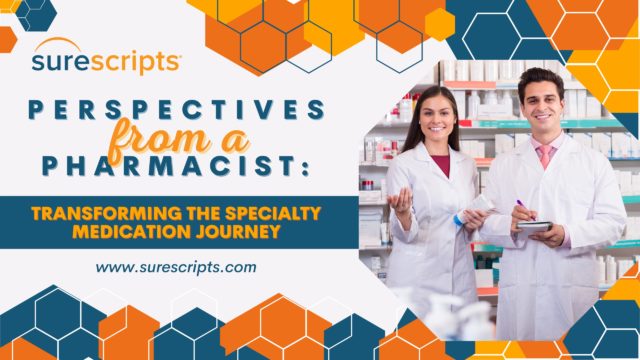By Cecelia Byers, Pharm.D., Specialty Clinical Product Advisor at Surescripts

Ask any pharmacist and they will tell you – the treatment journey for those living with specialty conditions can not only be costly, but complex.
In fact, specialty medications now account for more than half of medicine spending in the U.S. and retail prices for widely used specialty drugs increased at more than three times the rate of general inflation in 2020. At the same time, the burden of prior authorizations is growing, with 57% of pharmacists reporting an increasing number of requirements and a quarter state that they still use fax machines to process them.
What does this mean for prescribers, specialty pharmacists, and patients? Too often, inefficient, manual processes – from the way prescriptions are sent to specialty pharmacies to communication among those responsible for delivering medications – cause unnecessary delays in care and prevent people from obtaining the medications they desperately need. But with new technology solutions emerging across the industry, we have a real opportunity to eliminate friction throughout the entire specialty journey.
Supporting Healthcare Professionals and Powering Patient Care Teams
Fulfilling specialty medications requires much more patient and clinical information than non-specialty prescriptions. Manually gathering this information can take an inordinate amount of time and effort, especially completing the process of prior authorization, which is notoriously error-prone and a major source of delays for pharmacists and prescribers alike.
Often, specialty pharmacies will work with prescribers to initiate or complete the prior authorization, requiring clinical and insurance benefit information to ensure an understanding of not only alternative medications but the costs patients can expect. This prompts the need for additional financial assistance from either copay assistance programs or non-profit foundations.
While these actions are taking place, patients and their caregivers often experience a time-consuming process themselves, filled with unknowns and time spent worrying and wondering when they’ll start treatment. During my time as a specialty pharmacist, patients would often call me and say, “I called my doctor, but my doctor told me to call you.” Or, I would call them and say, “We need you to call your doctor and try to get them to take action on this next step.” Unfortunately, patients are often caught in the middle, either having to take action or being stuck with inaction.
But today, services such as Electronic Prior Authorization have taken off, enabling pharmacists to start prior authorization requests as part of their workflow. We’ve also seen tremendous growth of programs like Surescripts’ Specialty Medications Gateway and Specialty Patient Enrollment which deliver patient specific clinical data, from the prescriber’s electronic health record, directly to the specialty pharmacies when more information is needed. The number of Specialty Medications Gateway transactions was 421% higher in the first five months of 2022 compared to the same time period in 2021.
By streamlining these processes, we can better help specialty pharmacies serve patients with serious and complex illnesses and get them started on treatment faster.
Although not initially used for specialty prescribing, Real-Time Prescription Benefit enables prescribers to see cost information upfront for specialty medications. This solution not only supports prescribers with the medication selection process but allows them to consider what medications health insurance companies will cover and what those costs will be. In May alone, prescribers using Real-Time Prescription Benefit saved patients an average of $534.74 per specialty prescription. Using this solution at the point of prescribing can mitigate uncomfortable price conversations when patients reach the specialty pharmacy.
Building a Better Specialty Experience
When information is available at the moment it matters most, it means one less phone ringing, one less fax machine spewing paper and time saved across our healthcare system. This time cannot be measured by just the length of a phone call – it is time given back to patients, who no longer need to wait and worry about the next steps of their treatment.
As we look ahead, I am optimistic that our industry will become more committed to the vision of electronic integrations – making digital information sharing and electronic prescribing the norm. By integrating these tools across our industry, we can give pharmacists and physicians time back to focus on what matters most – our patients.

